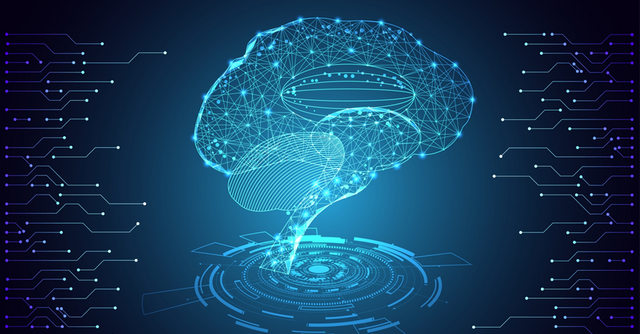The holographic brain
The Steemian @jsmarketing had commented 2 weeks ago at one of my last brain posts here. I had heard of such cases before but I became curious and so I searched for them because they fit my brain theme. I found more than what I was looking for. Such cases don't seem to be a single case and there were and are scientists who not only investigate such cases, but also start to think further and ask themselves essential questions about life and being. That made me curious about more. The nice thing is when scientists start not to limit themselves to something specific, but to conduct interdisciplinary research. Only a few scientists understand that everything is connected with each other and know not only how to look straight ahead but also how to look around. In order to find answers, questions have to be asked and in order to achieve progress, boundaries have to be crossed.
In his lifetime, the quantum physicist Professor Karl H. Pribram had tried to find a proof that the brain works holographically. Pribram has worked at Georgetown University, Stanford University and Yale University, among others, and in his long career he has extensively researched the cognitive functions of the human brain and the neurological functions of memory, emotions, motivation and consciousness. The professor wanted to find out how it is possible for memories to be stored in the brain and in which regions this takes place. In the course of this, he finally discovered that our brain is holographic in nature: memories are not stored in a certain area of the brain, but are apparently distributed throughout the entire brain.
The brain itself seems to be more of a receiver and does not produce these complex functions independently. Shocking facts have been provided by studies which have shown that today there are people who lead a normal life but have no or only a very tiny brain - something like this cannot be explained at all.
In the Lancet study conducted in 2007, a French worker was examined who complained of weakness in his left leg and had to go to hospital for examinations. It was found that the 44-year-old had never developed a normal brain as an infant due to an illness - it had remained tiny. Nevertheless, the man led a normal life, was married and had two children. Neuropsychological tests showed that he had an IQ of 75 and a verbal IQ of 84. The doctors were very surprised by this fact, because the scans showed that his skull was mainly filled with fluid! This means that this man survived with only 10% of an ordinary human brain. Nevertheless, his consciousness developed completely normally and the brain performed all necessary functions and could adapt. This shows that our brain is very plastic and can compensate for such damage when it occurs in early childhood. Different parts of the brain can obviously take over the tasks and functions of other parts!
A similar case was investigated by neurologist Dr. John Lorber (1915-1996) at the University of Sheffield. In the 1970s, he had a student who had an unusual head shape - the head was slightly larger than normal. Instead of a normal brain this student had only a 1 millimeter (!) thick brain layer in his skull and the rest was filled with brain water! Due to a hydrocephalus, the brain had no place to develop normally, and such cases usually lead to death or serious disability in the first months of life - but not in this case! The student was otherwise completely normal and healthy, even had an IQ of 126 and completed his studies without any problems. Dr. Lorber collected data from similar cases and found out that several hundred people had the same problem, but they lived completely normally even though they had no brain at all.
Dr. Lorber therefore had to ask himself whether humans need a brain in order to survive, or whether even a tiny part of a normal brain is enough to perform all normal functions. The doctors could not really explain this fact to themselves and said that such a thing should be impossible under normal circumstances. Even people who had part of their brain surgically removed almost never showed any form of memory loss - no matter which part of the brain was removed. The memories cannot be erased because they seem to be present everywhere in the brain at the same time. What explanation is there for all this?Professor Pribram believes that there is no explainable mechanism for this other than the concept of holography, because here too all the information is present and stored in every part of the hologram. Each small part contains the whole complex version of the original. That is why our brains and our memories must work like a hologram. The memories are not stored in certain parts of the brain, but circulate as impulses constantly through the whole brain, similar to laser light circulating through a piece of film containing a holographic image. So if the whole brain contains all the memories, then logically it must be a hologram itself.
Our almost supernatural ability to immediately retrieve any information from our brain memory is similar to the ability of a hologram, which also has enormous storage capacities for information. Many neurophysiologists now agree with Professor Pribram's claims and think that everything has to do with quantum physics. Recent considerations suggest that our brain is actually a quantum computer. There are still many aspects and functions of the human brain that cannot be explained otherwise.
Scientists from the University of California, Berkeley, are investigating the holographic nature of our brain and have announced their studies. They were able to produce holograms with simple light into the brain, which then stored memories that never actually happened. These studies offer a wide range of application possibilities, such as making deaf people hear again or blind people see again or healing psychic sick people again, but the whole thing has a bland aftertaste - you can manipulate people very badly with it. But apart from that, it shows that Dr. Pribram was right with his research and that the brain works holographically.
Scientists now want to find out exactly what this is and ask what a human actually is. The key to understanding our universe is our consciousness, which still cannot be fully understood. Only through quantum theory can it possibly be fully explained.
The theoretical physicist Matthew Fisher is currently working as scientific director of the Quantum Brain Project at the University of California to prove that our brains actually function like quantum computers. In some tests, Fisher has already been able to precisely identify some arrangements of biological components and certain key mechanisms that could serve as the basis for quantum processing in the brain. The research is expected to be completed in the coming years. If these theses prove to be correct, then it could finally be explained that we exist in a timeless space in which every human being and every living being possesses a unique quantum code. During the dying process we simply change from one quantum state to another, and therefore no real or final death can exist.
To understand all this, there must be a complete paradigm shift in the near future. The validity of our everyday reality is no longer given with these new insights and it turns out that our perception of the universe is actually based on a non-locality or an illusion. The universe itself must have qualities that depend on an observer - and we are all that observer.
According to our observations and thoughts, our reality, space and time are aligned. This hitherto unknown property is omnipresent everywhere in the universe and acts from the background by the quantum entanglement. Basically quantum physics proves that our objective reality does not exist at all...





Hi @oendertuerk, doesn´t this concept of a holographic brain fit nicely to the findings of Max Tegmark who says consciousness is being just the way matter is arranged or consciousness is how matter feels when it is arranged in specific, complex patterns.
yeah, that is one way how you can express it.
Max Tegmark assumes that there are parallel worlds and that each one of these worlds is branched with the others. Each one of these parallel worlds is a single mathematical construct with its own code. To maintain and run such a construct at the same time, it needs a complexity that can only be created and run with or as a hologram. just like our brains do.
I think a scientist’s job is to explain peoenomenon to the lamen. Now that the lamen seem more and more willing to accept quantum physics, I do believe we will see the shift that you refer to.
It seems to me the most convincing proof is in The quantum entangled particles theory of data packets that can travel faster than the speed of light and arrive at any destination in the universe instantly! This can only happen in a huge computer hologram simulation!
Posted using Partiko iOS
there is no other way to explain it, because nothing is faster than the light, except the light itself. this is paradox, but according to research quantum mechanics shows exactly that.
human brain is most complex human organ to explain but you explained phenomanelly well.
thank you
I was interested in this post. Prepared professionally, worth voting and sharing. All the best from @aple
thank you @aple
my best wishes back ;)
A hologram is a 3-dimensional image. The idea of holographic photography was introduced from 1947 by Dennis Gabor, who won a Nobel Prize for his efforts. The actual building of a hologram had to wait patiently until 1965, following the creation of the laser beam, when Emmett Leith and Juris Upatnicks made the first powerful holographic images. For your Soul Surfer, one of the fascinating things about holograms is they're assembled of waves. Take a pebble and drop it in the water. The pebble disturbs those surface of those water and produces a series of waves which spread out in nice fine concentric circles.
Take another pebble and dip it from the water somewhere else. When these waves fulfill other waves, they create what's called an interference pattern. They interfere together and break into an intricate pattern of peaks and troughs. To the naked eye, what was formerly a smooth chain of waves becomes a mixture of waves, but it's been shown that this apparently chaotic jumble also adheres to a blueprint. Even when we make a hailstorm in sea, the resulting interference blueprint on the surface of the sea stays a blueprint. In case of a hologram made with light beams, the interference blueprint created by the laser beam and after that stored on a special type of movie is what creates the eerily realistic holographic picture potential.
Simply fascinating!!
I don't really understand it all technically, yet I do. It's almost the way it has to be.
I have worked with many brain damaged people and there is no rhyme or reason as to correlation between extent and location of damage to the outcome.
I also find it fascinating and very exciting.
Awesome Post!
This Idea was brought to me 15 years ago by universal quantum information input. ;)
Thats not shocking. It's obvious. ;D
so true :)))
"Stalking the Wild Pendulum" by Itzhak Bentov. I feel like you'd enjoy this book=) Great post!
thank you for the book tip, i will take a look at it ;)
Excellent and insightful post!
Posted using Partiko iOS